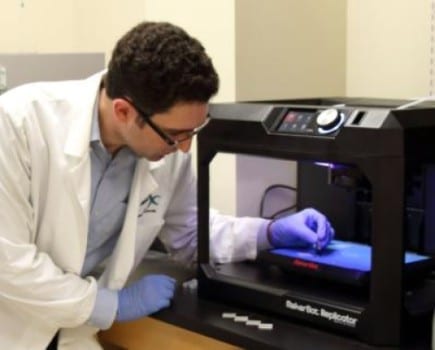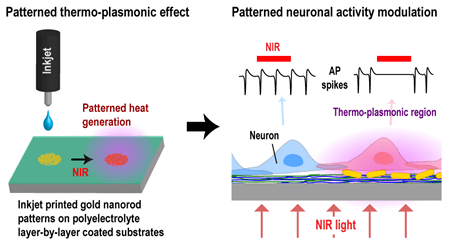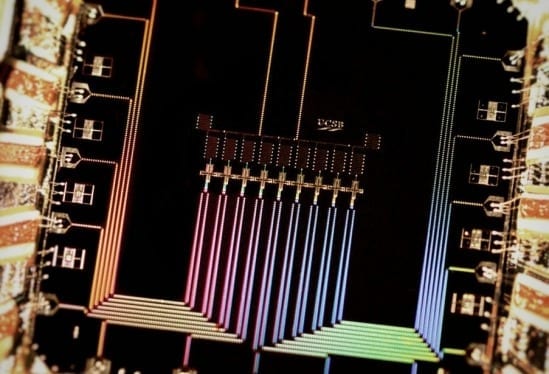
Interventional radiologists use 3-D printers to develop personalized medical devices that can deliver antibiotics and chemotherapy in targeted manner
3-D printing could become a powerful tool in customizing interventional radiology treatments to individual patient needs, with clinicians having the ability to construct devices to a specific size and shape. That’s according to a study being presented at the Society of Interventional Radiology’s Annual Scientific Meeting. Researchers and engineers collaborated to print catheters, stents and filaments that were bioactive, giving these devices the ability to deliver antibiotics and chemotherapeutic medications to a targeted area in cell cultures.
“3-D printing allows for tailor-made materials for personalized medicine,” said Horacio R. D’Agostino, M.D., FSIR, lead researcher and an interventional radiologist at Louisiana State University Health Sciences Center (LSUH) in Shreveport. “It gives us the ability to construct devices that meet patients’ needs, from their unique anatomy to specific medicine requirements. And as tools in interventional radiology, these devices are part of treatment options that are less invasive than traditional surgery,” he added.
Using 3-D printing technology and resorbable bioplastics, D’Agostino and his team of biomedical engineers and nanosystem engineers at LSUH and Louisiana Tech University developed bioactive filaments, chemotherapy beads, and catheters and stents containing antibiotics or chemotherapeutic agents. The team then tested these devices in cell cultures to see if they could inhibit growth of bacteria and cancer cells. When testing antibiotic-containing catheters that could slowly release the drug, D’Agostino’s team found that the devices inhibited bacterial growth. Researchers also saw that filaments carrying chemotherapeutic agents were able to inhibit the growth of cancer cells.
“We treat a wide variety of patients and, with some patients, the current one-size-fits-all devices are not an option,” added D’Agostino. “3-D printing gives us the ability to craft devices that are better suited for certain patient populations that are traditionally tough to treat, such as children and the obese, who have different anatomy. There’s limitless potential to be explored with this technology,” he noted.
Read more: 3-D printing offers innovative method to deliver medication
The Latest on: Personalized medical devices
[google_news title=”” keyword=”Personalized medical devices” num_posts=”10″ blurb_length=”0″ show_thumb=”left”]
via Google News
The Latest on: Personalized medical devices
- Vishay Intertechnology Space-Grade Planar Transformers Offer Lower Cost, Smaller Size, and Higher Density Than Traditional Planar Deviceson May 8, 2024 at 10:00 am
Vishay Intertechnology, Inc. (NYSE: VSH) today introduced a new series of low profile, space-grade planar transformers for power conversion applications. Offering a lower cost, smaller size, and ...
- AI-driven model identifies potent cancer-killing immune cells for personalized immunotherapyon May 7, 2024 at 9:46 pm
Using artificial intelligence, Ludwig Cancer Research scientists have developed a powerful predictive model for identifying the most potent cancer killing immune cells for use in cancer ...
- Global Durable Medical Equipment Rental Market for Remarkable Growth, Expected to Reach US$47 Billion by 2033 at a 5.7% of CAGRon May 6, 2024 at 6:28 am
The Global Durable Medical Equipment Rental Market is anticipated to grow to US$47 billion by 2033. With a compound annual growth rate (CAGR) of 5.7% for the anticipated period (2023–2033), this ...
- Terumo Aortic Receives King’s Award for Innovation for Custom Solutions Programon May 6, 2024 at 6:19 am
Terumo Aortic announced that it received the King’s Award for Enterprise in the Innovation category for its global custom solu ...
- Magnus Medical launches Saint neuromod system for major depressive disorder treatmenton May 1, 2024 at 9:43 am
Magnus Medical announced the commercial launch of its Saint neuromodulation system for treatment-resistant major depressive disorder (MDD).
- New Dimensions in Medical Tubing and Cableson May 1, 2024 at 9:12 am
Putnam Plastics brings FEP heat-shrink tubing extrusion — minus processing aids — in house, and GlobTek launches a line of PVC cables designed for healthcare environments.
- Absolute Robot Grips New Role as Custom Automation Integratoron April 30, 2024 at 10:46 pm
“This year at NPE, we are showing off the full bandwidth of our capabilities as a custom integrator.” That’s the mission statement for this week in Orlando, states Tim Lavigne, business unit manager ...
- Ricoh and SimBioSys Partner on AI-Powered 3D Models for Personalized Breast Cancer Treatmenton April 26, 2024 at 6:59 am
By joining forces, these two companies are committed to pushing back the boundaries of medical innovation by combining SimBioSys’ cutting-edge artificial intelligence with Ricoh’s 3D printing know-how ...
- 3D Printing Medical Devices Market Set to Grow to USD 10.67 Billion by 2031 Owing to Growing Demand for Personalized Medical Solutionson April 25, 2024 at 9:38 am
D Printing Medical Devices Market Set to Grow to USD 1067 Billion by 2031 Owing to Growing Demand for Personalized Medical Solutions ...
- U.S. health care evolving to become more personalized, consumer-focused, research findson April 25, 2024 at 8:13 am
Trends that could impact the market’s future, include the potential for future pandemics, emerging advancements in healthcare technologies and an aging population.
via Bing News










